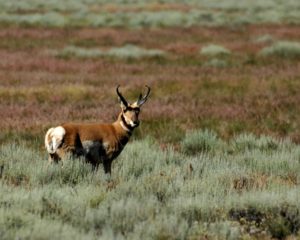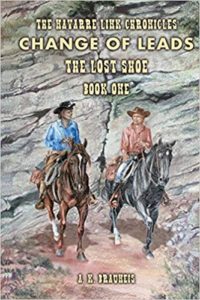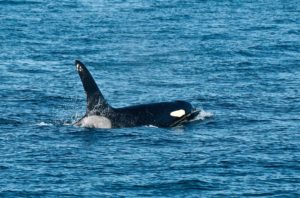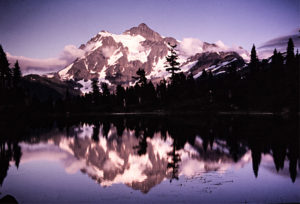
To experience unique wildlife, Hart Mountain National Antelope Refuge fills the bill. In this remote wilderness you may experience wildlife in a dramatic setting so stark it will take your breath away. Located in the high desert country of south central Oregon, and maintained by U.S. Fish and Wildlife Service, the refuge is open to the public year round.
Hart Mountain is a rugged, massive fault block ridge rising 8,065 feet above sea level. The craggy west side ascends abruptly from the floor of Warner Valley to dramatic, colorful cliffs and ridges. Several deep gorges slash the ridges. The east side of Hart Mountain is less rugged and forms a series of more gentle hills and low ridges. Its lower regions grow sagebrush and grass ranges typical of south central Oregon.
Because of its many springs, Hart Mountain has been called an oasis in the desert. The refuge at Hart Mountain is remote with no grocery or gasoline facilities available. May through October is the best season to visit the refuge. Even then, road conditions may limit access to parts of the area. RVers, especially those with large rigs, may want to consider driving to the refuge in a smaller vehicle.
We were on a sharp lookout for antelope, sometimes called pronghorn. Antelope are shy animals and will bolt at the slightest fear of danger. Antelope, North America’s swiftest mammal, can reach speeds of more than 40 miles an hour and can cover 20 feet in one leap. These deerlike animals are characterized by their curved, hollow horns with a single forward-projecting prong on each horn. The antelope’s tan body has a white belly and two white stripes on the neck and chest.
At one time, before the settlers came to America, Hart Mountain was the home of bighorn sheep. Indigenous writing on rock walls shows figures of wild sheep, indicating they were an important source of food. The first settlers also hunted the sheep. Large herds of domestic livestock were eventually brought into the area causing competition for forage. Diseases introduced to the bighorn sheep also contributed to their disappearance by the early 1900s. In November 1954, 20 bighorn sheep were donated by British Columbia, reestablishing the bighorn at Hart Mountain.
Visitors normally have to work to see bighorn sheep although herds are occasionally seen from the road. Usually, they are easier to spot along cliff areas if you are above them, which means taking a steep hike. Bighorns have the capacity for climbing and jumping due to the structure of their hoofs. The halves of each hoof separate allowing the feet to cling firmly to rocky terrain.
Mule deer are routinely spotted anytime of year, though spring and summer are the best times. The mule deer, named for their large, mule-like ears, avoid human activity but can be seen along forest edges or on brushy slopes in the foothills.
About 200 resident migratory bird species use the refuge, often seen along riparian areas along the edge of a stream or river. The air is alive with their songs. Sage grouse are often spotted around meadows and their kuk, kuk, kuk can be heard as they search for food among the sagebrush.
Wild flowers abound throughout the refuge. In June, fields of iris danced in colorful display. We also found Indian paintbrush and brilliant yellow arrowleaf balsamroot. Photographers will find plenty of subjects to capture.
The thirty campsites on Hart Mountain’s Hot Spring Campground are primitive with no RV hookups, drinking water, firewood or fire rings. There are pit toilets, two of which are handicap accessible. Drinking water is available at headquarters. There are no reservations and no camping fees. A hot springs enclosure allows visitors to enjoy warm waters with an open view of the sky.
Visitors might consider making this refuge a day trip and camp in the Lakeview area where there are U.S. Forest Service camps or Goose Lake Oregon State Park. Goose Lake, off US 395, 14 miles south of Lakeview, has 48 sites with electricity and water. Showers are available and there is a dumping station. The park has boat facilities and excellent wildlife viewing. The lake spans two states, Oregon and California.
Be sure to visit the Refuge headquarters which has several interesting displays and pamphlets.
An interesting outside display identified many of the native plants found on the refuge: wild-rye, hawksbeard, Indian ricegrass, low sagebrush, rough fescue, Idaho fescue, balsamroot, bluebunch wheatgrass, bitterbrush, and big sagebrush. Each of these plants is vitally important to ensure adequate cover and nutrition for many resident species.
If you’re looking for a memorable wildlife experience, consider visiting Hart Mountain National Antelope Refuge. You’ll be awe-inspired with the spectacular views and fascinated with the abundant wildlife.
For more information, visit https://www.fws.gov/refuge/Hart_Mountain/visit/plan_your_visit.html
 Where the Crawdads Sing by Delia Owens is a memorable book on many levels: complicated family dynamics, a little girl’s struggle to survive, wildlife, and the nature of people. The story takes place almost entirely in North Carolina marshland and toggles between the 1950s and 1960s.
Where the Crawdads Sing by Delia Owens is a memorable book on many levels: complicated family dynamics, a little girl’s struggle to survive, wildlife, and the nature of people. The story takes place almost entirely in North Carolina marshland and toggles between the 1950s and 1960s.









